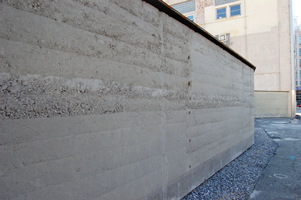





Conclusion
Building with rammed earth wall at MIT has demonstrated that the method is appropriate to New England The principal question remaining to be answered is what soil to use in construction. The technique of soil processing employed in the construction of the demonstration wall is located between two existing methods observed in the first stage of research. The first method, a traditional approach, utilizes soil as it occur naturally on or near the building site. This method is the most advantageous environmentally, but can require testing for each particular project as soils vary widely and sometimes unpredictably. In the second method, most often followed by rammed earth builders in the Southwest United States, builders mix engineered road building soils with a small amount of portland cement. While this approach offers predictable performance, it requires the use of cement, whose environmental costs have been outlined above, and often employs soils transported far from their initial location, raising the environmental cost. While both of these methods have been employed successfully in a range of projects, either might be considered a compromise.
The use of marine clay, a consistent material source abundant in the region, mixed with commercially-available, locally produced aggregates represents a third course, positioned between the two outlined above. This third method can be standardized without the addition of Portland cement due to the consistency of the clay. The method contains great promise because it offers predictable performance without the use of environmentally damaging materials. Nevertheless, a continuous-feed soil mixing and placement machine must be developed before building with engineered soil blends containing blue clay is practically and economically feasible. The design and fabrication of a combination soil mixing and placing apparatus is the next logical phase for rammed earth research.